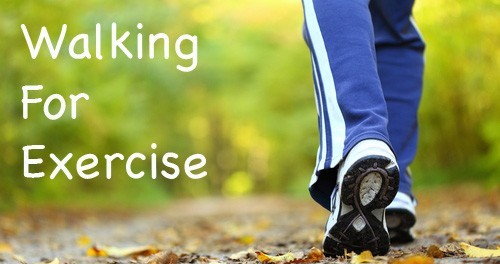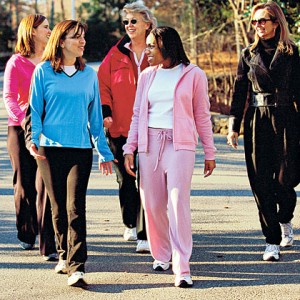Walk Talk Series
Day 29 – Walking Clubs and Fiber
Walking Clubs
Joining a club can keep you moving.
Walking with a club is a great motivator. Together, you are more likely to walk and less likely to let excuses get in the way. A walking club is a great way to find somebody who wants to walk the same speed, time, and schedule as you.
A club where you can meet a variety of walkers, who have some structured walking schedules, events, coaching or programs.
- More potential walking companions
- Interesting walking routes and events
- Wider range of advice, idea sharing and coaching
- Reward systems for achieving walking goals
Where to Find Walking Clubs
- IVV Volkssport walking clubs: Non-competitive walkers who participate in 6-mile walks on a regular basis
- Mall walking clubs: These clubs are organized individually, so call or visit your local mall to see if they have an organized program for walking. These clubs will generally concentrate on walking indoors for exercise.
- Running Clubs: Many running clubs also accept walkers as members, and some have a large contingent of walkers and many events organized for either runners or walkers.
- Medical centers and HMO’s are good places to contact to find local walking clubs, as many sponsor walking groups.
- Check your local running shoe stores for brochures and publications which list walking and running clubs.
- Health clubs may sponsor walking and running groups, and be sure to check their bulletin boards for brochures or announcements.
- Participate in a local charity walking event and ask others where to find walking clubs.
There are thousands of American Volkssport Association walking clubs around the country. The American Volkssport Association promotes health, fun, and fellowship through non-competitive walking and other sporting events for everyone.
Member Clubs:
Clubs host weekend events, the members selecting interesting trails and walking routes for everyone to enjoy. Club dues are usually minimal, often less than $10 per year. Clubs are a great way to meet other active walkers in your local area. Call the club contact to find out more! Visit https://www.ava.org/avaclub/avaclub.htm for more information
Today’s Walk
- 30-60 minute walk in the healthy heart zone 50-60% of your maximum heart rate
- Warm up with 5 minutes at a very easy pace
- Find a safe spot with a wall or pole to do a 5 minute easy stretching routine
- Now resume your walk at a comfortable pace
- End with 5 minutes of gentle stretching
Exercise: Upper Body Exercises
Advanced walkers: Distance Walk
Fiber
Because it causes gas, bloating, and other uncomfortable side effects, fiber may be the Rodney Dangerfield of food constituents. But with more and more research showing that a high-fiber diet may help prevent a cancer, heart disease, and other serious ailments, roughage has started to get some respect.
Adding Fiber To Your Diet
Research suggests that as much as 35 grams of fiber a day is needed to help reduce the risk of chronic disease, including heart disease. A fiber supplement can help make up the shortfall, but should not be a substitute for fiber-rich foods. Foods that are high in fiber also contain nutrients that may help reduce the risk of chronic disease.
Found only in plant foods, such as whole grains, fruits, vegetables, beans, nuts, and seeds, fiber is composed of complex carbohydrates. Some fibers are soluble in water and others are insoluble. Most plant foods contain some of each kind.
Fiber Content in Common Foods
Here is a list of common foods, according to serving size and their fiber content. You may notice slight differences in fiber content on food packages, in reference books or in brochures about food and health. That may be due to how the fiber was determined (there are a few methods), or that serving size varied, etc. Generally, fiber content is approximately the same for most foods. Some sources give the precise fiber content to the decimal (3.2 grams, for instance), while others round up (or down) to the nearest whole number. The numbers in the chart below are rounded, unless they contain less than 1 gram per serving.
| Food | Serving Size | Grams of Fiber |
| Fruits | ||
| Apple (with peel) | 1 medium | 3 |
| Banana | 1 medium | 3 |
| Blueberries | 1 cup | 4 |
| Cantaloupe | 1 cup | 1 |
| Grapefruit | 1 medium | 3 |
| Orange | 1 medium | 3 |
| Pear (with peel) | 1 medium | 4 |
| Pineapple | 1 cup | 2 |
| Prunes (dried) | ½ cup | 6 |
| Raspberries | 1 cup | 8 |
| Vegetables and beans | ||
| Asparagus (5 medium, cooked) | ½ cup | 2 |
| Kidney beans (cooked) | ½ cup | 6 |
| Pinto beans | ½ cup | 8 |
| Broccoli (cooked) | ½ cup | 2 |
| Carrots | ½ cup | 2 |
| Cauliflower (cooked) | ½ cup | 2 |
| Sweet potato, w. skin (baked) | 1 medium | 3 |
| White potato, w. skin (baked) | 1 medium | 5 |
| Spinach, frozen, cooked, drained | ½ cup | 3 |
| Tomato | 1 medium | 1 |
| Breads, cereals, grains etc. | ||
| Rye bread | 1 slice | 2 |
| White bread | 1 slice | 1 |
| Whole-wheat bread | 1 slice | 2 |
| Kellogg’s® All-Bran (original) | ½ cup | 10 |
| Kellogg’s ® All-Bran Bran Buds | 1/3 cup | 11 |
| Quaker® Old-Fashioned Oatmeal (cooked) | 1 cup | 4 |
| Wheat germ, toasted | 2 tablespoons | 3 |
| Brown rice, cooked | ½ cup | 2 |
| White rice, cooked | ½ cup | 0.3 |
| Spaghetti, cooked | 1 cup | 2 |
| Peanuts, dry-roasted | ½ cup | 6 |
Start Slowly
A word of caution: When increasing the fiber content of your diet, it’s best to take it slow. Add just a few grams at a time to allow the intestinal tract to adjust; otherwise, abdominal cramps, gas, bloating, and diarrhea or constipation may result. Other ways to help minimize these effects:
- Drink at least 2 liters (8 cups) of fluid daily
- Don’t cook dried beans in the same water you soaked them in
- Use enzyme products, such as Beano or Say Yes to Beans, that help digest fiber.
Health Conditions Benefiting From Fiber
Diabetes: As with cholesterol, soluble fiber traps carbohydrates to slow their digestion and absorption. In theory, this may help prevent wide swings in blood sugar level throughout the day. Additionally, a new study from the Harvard School of Public Health, published in the Feb. 12 issue of the Journal of the American Medical Association, suggests that a high-sugar, low-fiber diet more than doubles women’s risk of Type II (non-insulin-dependent) diabetes. In the study, cereal fiber was associated with a 28 percent decreased risk, with fiber from fruits and vegetables having no effect. In comparison, cola beverages, white bread, white rice, and french fries increased the risk.
Obesity: Because insoluble fiber is indigestible and passes through the body virtually intact, it provides few calories. And since the digestive tract can handle only so much bulk at a time, fiber-rich foods are more filling than other foods–so people tend to eat less. Insoluble fiber also may hamper the absorption of calorie-dense dietary fat. So, reaching for an apple instead of a bag of chips is a smart choice for someone trying to lose weight. But be leery of using fiber supplements for weight loss. In August 1991, FDA banned methylcellulose, along with 110 other ingredients, in over-the-counter diet aids because there was no evidence these ingredients were safe and effective. The agency also recalled one product that contained guar gum after receiving reports of gastric or esophageal obstructions. The manufacturer had claimed the product promoted a feeling of fullness when it expanded in the stomach.




